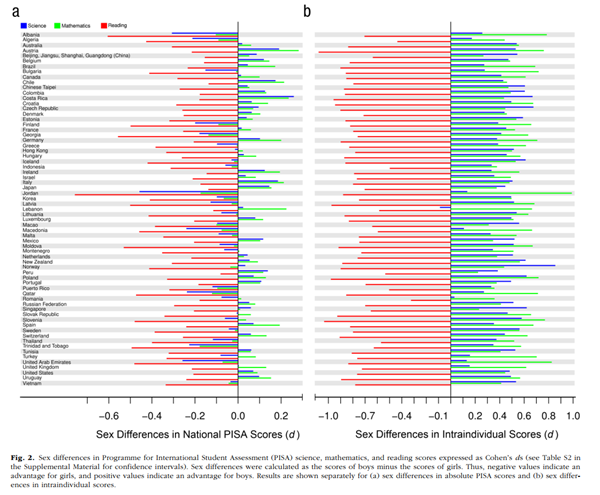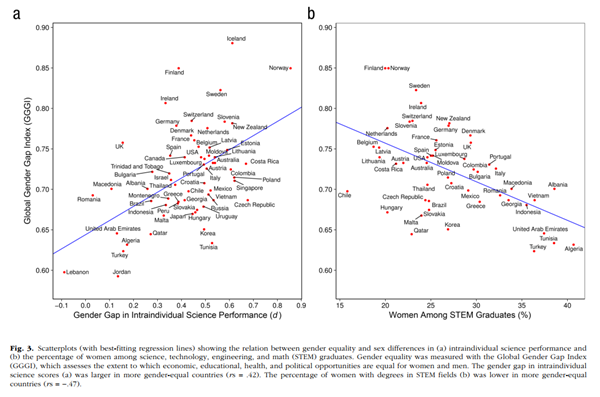Even with a question mark, the title “Do Boys Have a Comparative Advantage in Math and Science?” is likely to appear sexist. Am I suggesting boys are better at math and science than girls? No, I am suggesting they might be worse.
[russia]
Q2 hedge fund letters, conference, scoops etc
The Gender Equality Paradox
Consider first the so-called gender equality paradox, namely the finding that countries with the highest levels of gender equality tend to have the lowest ratios of women to men in STEM education. Researchers Stoet and Geary put it well:
Finland excels in gender equality (World Economic Forum, 2015), its adolescent girls outperform boys in science literacy, and it ranks second in European educational performance (OECD, 2016b). With these high levels of educational performance and overall gender equality, Finland is poised to close the STEM gender gap. Yet, paradoxically, Finland has one of the world’s largest gender gaps in college degrees in STEM fields, and Norway and Sweden, also leading in gender-equality rankings, are not far behind (fewer than 25% of STEM graduates are women). We will show that this pattern extends throughout the world…
(Recent papers have found the paradox holds in other measures of education such as MOOCs and in other measures of behavior and personality. Hat tip on these: Rolf Degen.)
Two explanations for this apparent paradox have been offered. First, countries with greater gender equality tend to be richer and have larger welfare states than countries with less gender equality. As a result, less is riding on career choices in the richer, gender-equal countries. Even if STEM fields pay more, we would expect small differences in personality that vary with gender to become more apparent as income increases. Paraphrasing John Adams, only in a rich country do people feel free to pursue their interests more than their needs. If women are somewhat less interested in STEM fields than men, then we would expect this difference to become more apparent as income increases.
A second explanation focuses on ability. Some people argue that more men than women have extraordinary ability levels in math and science because of greater male variability in most characteristics. Let’s put that hypothesis to the side. Instead, let’s think about individuals and their relative abilities in reading, science, and math; this what Stoet and Geary call an intra-individual score. Now consider the figure below, which is based on PISA test data from approximately half a million students across many countries. On the left are raw scores (normalized). Focus on the colors: red is for reading, blue is science and green is mathematics. Negative scores (scores to the left of the vertical line) indicate that females score higher than males, while positive scores indicate that males score higher on average than females. Females score higher than males in reading in every country surveyed. Females also score higher than males in science and math in some countries.
Mounting Differences
Now consider the data on the right. In this case, Stoet and Geary ask for each student what subject they are relatively best at, and then they average by country. The differences by sex are now even more prominent. Not only are females better at reading, but even in countries where they are better at math and science than boys on average, they are also relatively better at reading. The researchers noted:
Thus, even when girls outperformed boys in science, as was the case in Finland, girls generally performed even better in reading, which means that their individual strength was, unlike boys’ strength, reading.
Now consider what happens when students are told, ‘Do what you are good at!’ Loosely speaking, the situation will be something like this: Females will say, ‘I got As in history and English classes and Bs in science and math, therefore, I should follow my strengthens and specialize in drawing on the same skills required for history and English.’ Males will say, ‘I got Bs in science and math courses and C’s in history and English, therefore, I should follow my strengths and do something involving Science and Math.’
Note that this is consistent with the Card and Payne study of Canadian high school students that I discussed in my post, “The Gender Gap in STEM is NOT What You Think.” Quoting Card and Payne:
On average, females have about the same average grades in UP (“University Preparation”, AT) math and sciences courses as males, but higher grades in English/French and other qualifying courses that count toward the top 6 scores that determine their university rankings. This comparative advantage explains a substantial share of the gender difference in the probability of pursing a STEM major, conditional on being STEM ready at the end of high school.
And myself:
Put (too) simply the only men who are good enough to get into university are men who are good at STEM. Women are good enough to get into non-STEM and STEM fields. Thus, among university students, women dominate in the non-STEM fields and men survive in the STEM fields.
Finally, Stoet and Geary show that the above considerations also explain the gender-equality paradox because the intra-individual differences are largest in the most gender equal countries. In the figure below, on the left are the intra-individual differences in science by gender, which increase with gender equality. A higher score means boys are more likely to have science as a relative strength (i.e. women may get absolutely better at everything with gender equality, but the figure on the left suggests that they get relatively better at reading). The figure on the right shows that the share of women going into STEM fields decreases with gender equality.
Male dominance in STEM fields is usually seen as a result of a male advantage and a female disadvantage (whether genetic, cultural, or otherwise). Stoet and Geary show the result could actually be due to differences in relative advantage. Indeed, the theory of comparative advantage tells us that we could push this even further than Stoet and Geary. It could be the case, for example, that males are worse on average than females in all fields, but they specialize in the fields in which they are the ‘least worst,’ namely science and math. In other words, boys could have an absolute disadvantage in all fields but a comparative advantage in math and science. I don’t claim that theory is true, but it’s worth thinking about a pure case to understand how the same pattern can be interpreted in diametrically different ways.
Reprinted with permission from Marginal Revolution.
This article was originally published on FEE.org. Read the original article.
![]()


